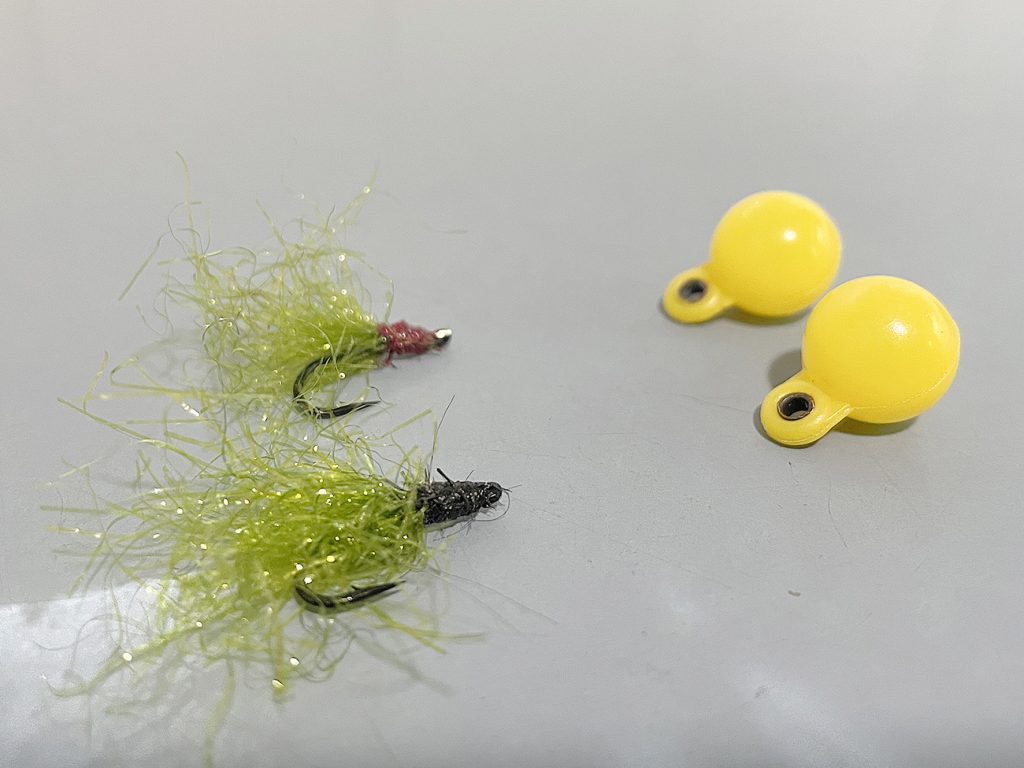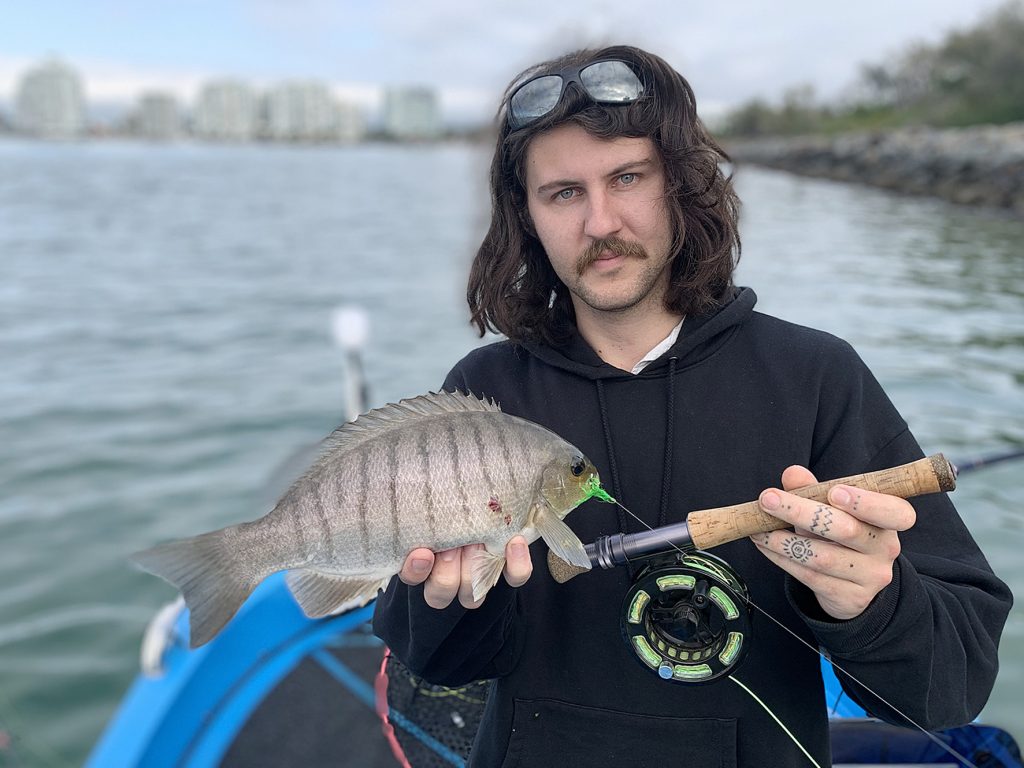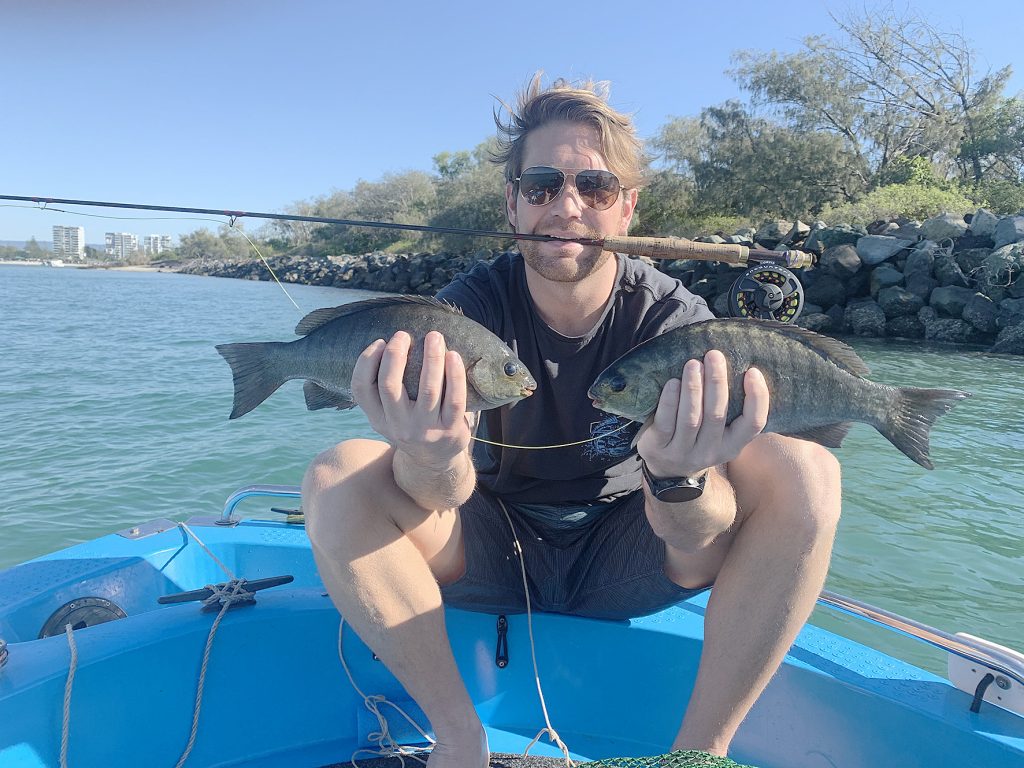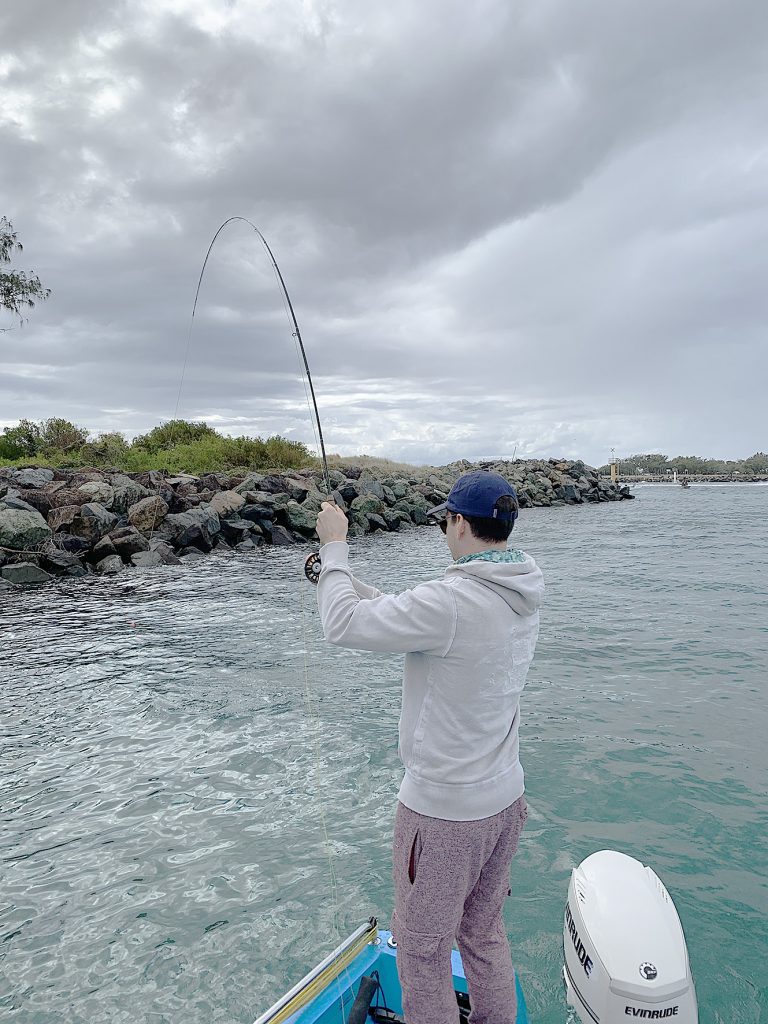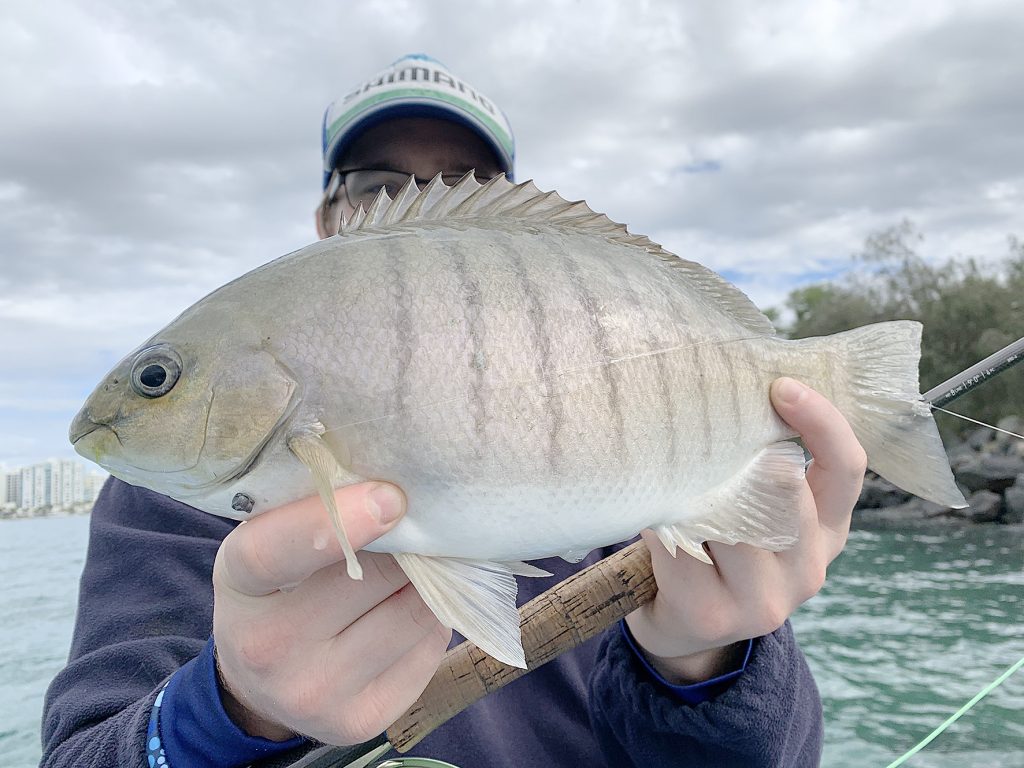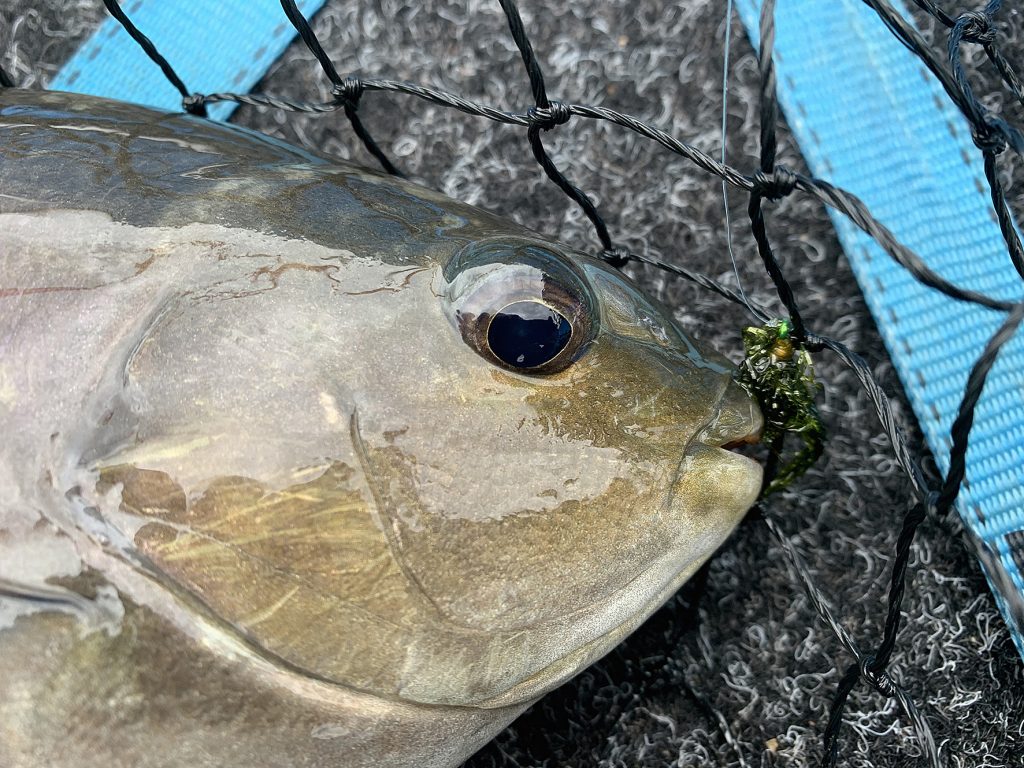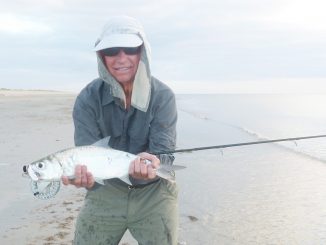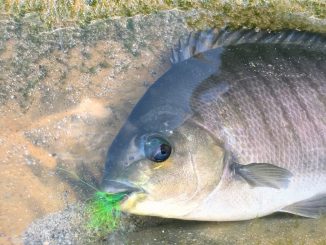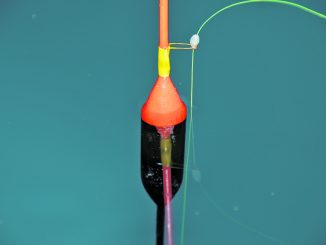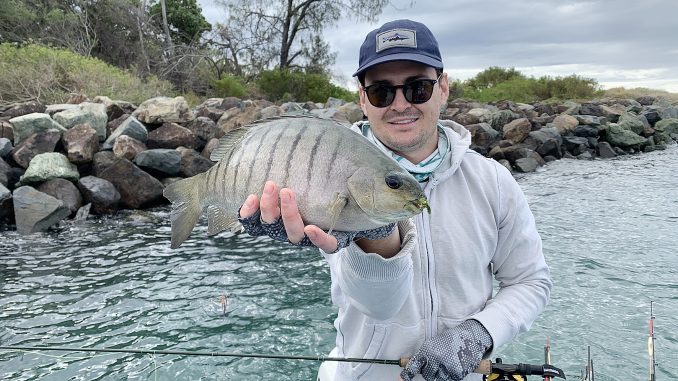
• by Lachlan Hickey
Luderick (or blackfish) have to be one of the most underrated and under targeted fish on fly gear. Readily available from about Hervey Bay in Queensland and down to most of Victoria’s coastline, vast populations of these wily little omnivores go about their days unbothered as anglers fixate on other species.
There is, of course, the community of mostly older anglers who choose to chase them with centrepin reels, long rods, pencil style floats and weed baits – a technique almost as old as European influence in Australia. This traditional form of fishing may seem completely alien to most lure and fly anglers, but there is considerable overlap.
Its similarity to flyfishing is undeniable, and in places where trout are only a short drive away, luderick fanatics will divide their time between these two cult favourites. But if traditional methods of blackfish angling aren’t for you, or you’re a fluff swinger wanting a new challenge, the good news is that luderick can be taken on fly tackle! Even better, the setup is pretty straightforward as far as flyfishing goes!
BASIC IS BEST
There is no need for specially designed glass rods upward of a thousand bucks, or flies that are so small and complicated they need to be studied under a microscope before they can be tossed into the water.
Given that you will be fishing in a saltwater environment, sometimes in areas where your rod and reel will cop a bit of spray, an outfit you don’t mind getting dirty or even damaged is a good idea – at least in the beginning. Anything between a 3-8wt is fine for rods, with an 8wt occasionally becoming necessary when these dirty fighters approach 50cm. There’s no need to spend more than $300 on a rod.
Basic fly reels can be very cheap, and for a technique that only requires the reel to hold the flyline, there’s probably no need to fork out any more than $150. The equipment I use regularly gets a run on other species, so by my own standards I have a fairly fancy blackfish rig, but it’s definitely not necessary.
For 95% of your fishing, a floating line is all you need. Luderick regularly feed in shallow water, and they can also be easily brought into your area with berley, and I usually find myself fishing in 10ft of water or less.
It’s easy to get into arguments about leaders, but my preference is a tapered leader around 8-9ft long – about as long as the rod blank – made up of fluorocarbon and finishing up with a 6-10lb tippet section. I like a tapered leader because it allows the fly to turn over, and prevents it from falling in a heap and tangling.
Flies aren’t as important as you might think. In turbulent washy areas or in a well-constructed berley trail, anything green is on the menu if the luderick are hungry. Small green weed patterns between size 4 and size 10 are fine. They’re easy to tie, and are even available from certain tackle shops and online retailers! The colour of your fly should match whatever is growing in the area, or whatever is in your berley if you’re berleying, but quite often it isn’t vital to success.
The weighting of your fly is important, and getting it down to where the fish are can be the difference between success and failure. While you can use a weighted fly, I prefer to use a small split shot just above my fly, about six inches or so. This helps to get the fly down to where the fish are, and not having it directly above the fly means it will waft naturally in the current, rendering the piece of green fluff all the more appetising.
CHOOSE YOUR OWN ADVENTURE
There is more than one way to fly fish for luderick. Where I fish in Southern Queensland, I like to anchor the boat in a channel, get a berley of chopped weed and wet sand going, and drift a weed fly under a large indicator perpendicular to the boat.
However, you don’t necessarily need a boat, or berley for that matter. What you will need though is an area where luderick are gathering in good numbers either to feed or to spawn.
Breakwalls, retaining walls, collapsed mangrove banks and weedy sand channels are classic haunts for blackfish chasers in the estuaries and bays, and in the cooler months these fish will gather in the channels that these structures create. A bit of current in these channels is always a good thing.
The lower ledges on the ocean rocks are a great place to target larger fish, which are usually there specifically to feed. It goes without saying that this is a potentially dangerous activity, and shouldn’t be done alone, or without local knowledge. As far as extreme sports go, wobbling around on slippery rocks fighting a 2kg fish on a noodle as a wave rushes past your thighs is up there with bull riding, boxing and gymnastics. And yes, I’ve seen old people doing this. With that said though, fly fishing in the wash is an awesome challenge, and it’s well worth doing if you are set up to fish the ocean rocks.
Indicator or no indicator?
An indicator is any object designed to sit above the fly somewhere on the leader and ‘indicate’ when the fly has been eaten, much like a float! In trout fishing, anglers will often use a piece of wool or something similar. I like to use a product called The Thingamabobber, which resembles a small buoy about an inch wide and is specially-designed for fishing larger flies in the turbulent salmon streams in the US. I’ll either loop it through, or jam a piece of a toothpick in the hole to stop it from sliding. You can use any kind of indicator, as long as it’s buoyant enough not to get dragged under by the fly or current. I have even used cheap bubble floats when I couldn’t find anything else!
When fishing with indicators, you’re not necessarily looking for the indicator to get pulled under like a float. While this is often what happens, well-practised anglers will learn to notice any change in the indicator’s trajectory. It might slow down, stop, speed up, move sideways – any movement that doesn’t seem natural should be struck at with the rod. I strike with my rod rather than by stripping because there is often a belly in the line created by the current, and stripping to gain tension with a 6lb tippet probably isn’t going to end well.
I choose to use bright, highly buoyant indicators because my skills in this area are basic at best, however smaller and less conspicuous indicators are fine if you are practised enough to fish with them. I have one friend who’s honed their skills on trout so well that they can outfish me by just watching their leader knot!
The drop underneath your indicator will vary depending where you fish, but as a rule I like to start with around 1m of drop and make adjustments throughout the session based on what’s happening. To be honest, most of the time it doesn’t matter too much, just as long it’s below the surface.
When fishing across the current, mending your line becomes a valuable skill. Mending is using the rod to rearrange the line so that it doesn’t drag the fly around unnaturally. This is always easier done with a floating line. You’re trying to keep the line between you and the indicator as straight as possible. A belly will start to form, and this is unavoidable, but keeping it to a minimum means there’s less slack between you and the fish when it comes time to strike. I try to mend only when it’s necessary, as I don’t like to disturb the fly too often.
You don’t have to be Lefty Kreh to fly fish without an indicator for luderick, in fact, in certain scenarios no indicator is preferred. On the ocean rocks is a good example. The wave action would make keeping track of a small indicator frustrating at the very least, so a good trick to fishing the wash zones is to slowly retrieve the fly, just fast enough to stay in contact with it. It can be as slow as a foot every five seconds.
If and when a peckish blackfish eats the fly, you should notice the bite instantly and either strip strike instinctively (be careful not to pull too hard and break the leader), or have enough warning to swiftly ‘trout’ strike.
Whether or not you’re using an indicator, it’s worth remembering that hook-sets are free. If you notice any hesitation in the system at all as you drift your fly, striking at nothing is better than missing out on a fish. You can always false cast and drop it back in the zone in a matter of seconds. It’s one of the benefits of fly fishing!
On the topic of rigging, I have even heard of inventive fluff chuckers fishing a trout-style dropper rig – that is, a dry fly with a smaller wet fly suspended underneath about a foot or so. A luderick eating a dry fly really completes all the trout comparisons that these unassuming little fish get.
With fishing two flies in tandem obviously not off the table, I have watched friends fish with two under an indicator at once. If you end up having to fight a pair of these things simultaneously on a trout-rated rod, you’ll know about it.
Berleying
This is something that other writers have covered, however the how-tos and benefits can bare retelling.
With berley, it’s all about the weed, man. Sometimes berley is necessary if the fish aren’t schooling up or you just can’t find them in any other way. Berley is a great way to bring the fish to you and keep them there.
Creating a good berley mix is a little extra effort, but well worth it if you’re going to be fishing in calmer areas; the foamy wash areas tend to create their own berley trail as waves crash over the rocks and drag in small pieces of weed and cabbage as the water recedes.
I like to get a bucket and throw in a few handfuls of finely chopped sea cabbage or green weed, and then mix in a few scoops of semi-wet sand. The ratio doesn’t matter too much – about half-and-half should be fine.
The trick is to mould golf ball-sized bombs in your hands with the mixture and lob them into the drink. As it plops into the water, the sand should see the naturally-floating weed falling slowly through the water column and drifting along the channel.
You might be surprised how quickly this can bring luderick and other weed eaters like mullet, bream, sicklefish, drummer and butterfish to your area.
Tales of old hands using lawn trimmings and frozen peas in their berley mix are not unfounded, as I have discovered myself. If you find yourself unable to procure fresh weed, this may get you out of a rut.
BENDING
Once you are hooked up to one of these little pocket rockets, you’re in for a real treat. Their hard runs for cover and tendency to roll around when hooked makes each fight enjoyable. It’s important to play them out, especially if using light gear. Old timers will use their long, soft rods to tire them out, making sure the small hooks stay in, and using the fly rod follows very much the same principle.
With a fly setup, you have a long shock absorbing rod paired with line that has a lot of stretch, so it’s important to keep a good bend in the rod as you play them. Try not to point the rod at the fish, because if they go for one of their ‘out of nowhere’ lunges for cover, you’ll risk breaking your tippet. Remember, you’ve only got 4-8lb fluorocarbon on the business end and it won’t take much to break it!
HUNTING AND GATHERING
Whether you want to take a few for a feed or not is up to you. I don’t buy into the whole business of not eating something because I caught it on a fly rod. Luderick taste great, and I’m a hungry boy, so usually I’ll take 3-4 for myself and let the rest go. There is plenty of luderick to go around, believe me!
As with most estuary fish, bleeding them immediately before letting them firm up for an hour or two in an ice slurry is the best way to look after your catch. I don’t bother brain spiking them, but many anglers swear that this improves the quality of the meat.
YOUR NEXT FLY CHALLENGE
Any fly fishers looking for their next challenge, or any blackfish anglers wanting to add a twist to their seasonal harvest should definitely add this to their list.
A trout fishing friend of mine told me it was as good as nymphing for trout, and posed a similar challenge. There might have been speedboats instead of tractors, rock walls instead of tussocks, and sunburnt billionaires instead of farmers, but I could see what he was getting at.
The cooler months are favoured for this pursuit, however in many areas, particularly those toward the southern limit of their range, they will bite all year, making them the perfect before or after work option.
There’s still a few months left of prime time to get stuck into these great estuary battlers, so go and check it out for yourself!

